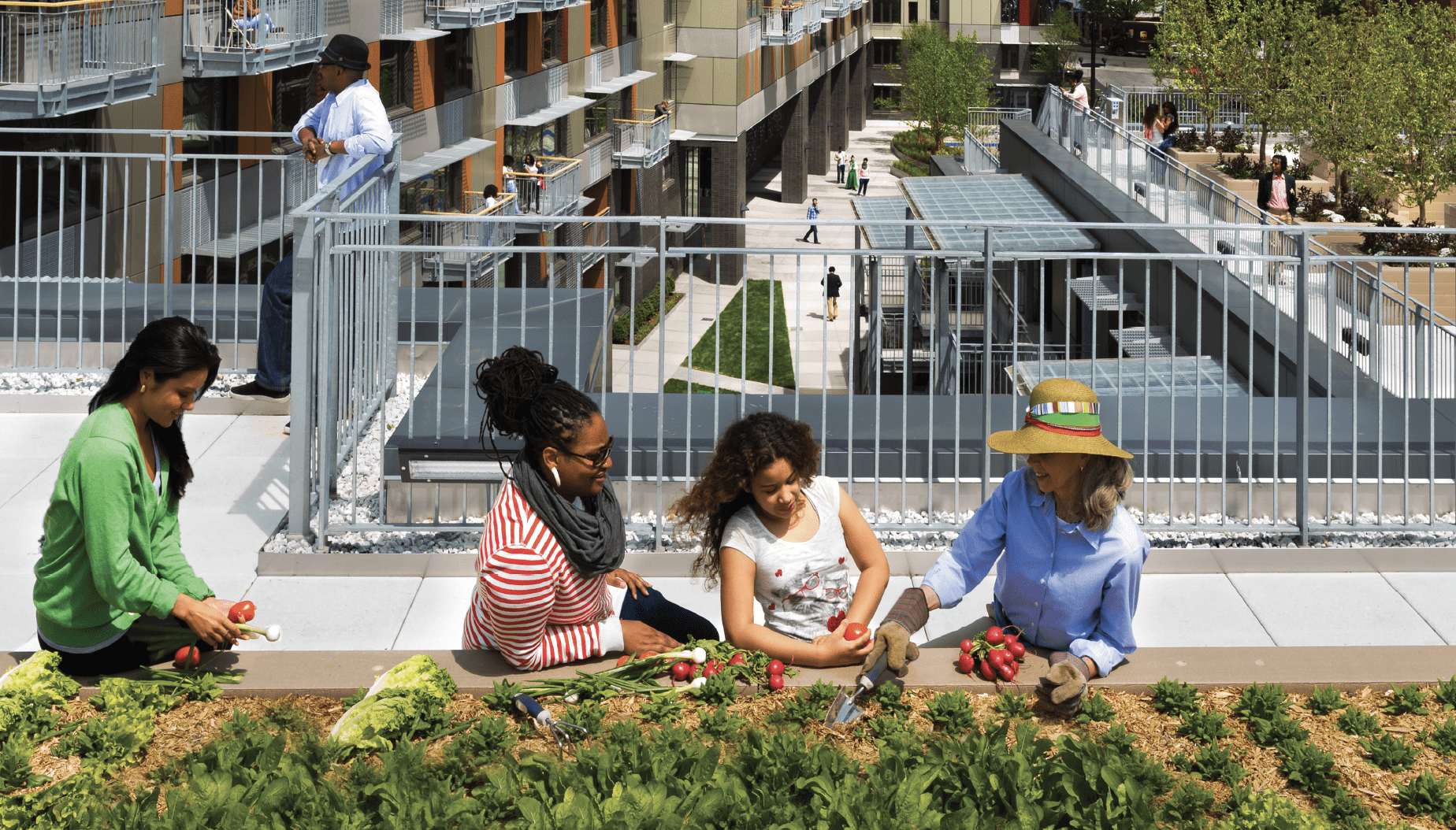This article appears in Summit Journal (Fall 2020) | Download PDF | Listen to the Podcast
How business values focused on regeneration can support an informed and enhanced response to COVID-19.
WHAT IS A REGENERATIVE BUSINESS?
Despite an emerging literature on regenerative business, very few authors clearly define what a regenerative business is. For example, the 2014 HBR article, “The Seven Laws of Regenerative Enterprise” only defines a regenerative enterprise in its last sentence, as “one that thrives forever.” [1] Carol Sandford, in her book, Regenerative Business, never defines a regenerative business, but defines regeneration as “a process by which people, institutions and materials evolve the capacity to fulfill their inherent potential in a world that is constantly changing around them.” [2]
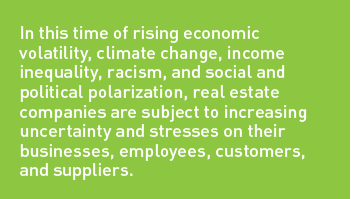
Perhaps the best definition comes from John Fullerton’s 2015 White Paper Regenerative Capitalism, How Universal Principles and Patterns Will Shape Our New Economy in which he describes regenerative capitalism as “the application of nature’s laws and patterns of systemic health, self-organization, self-renewal, and regenerative vitality to socioeconomic systems.”[3]
We define a regenerative business as one whose purpose, products, and processes enhance the ecological and social commons. Real Estate is particularly well suited for this.
DEVELOPING COMMUNITIES OF OPPORTUNITY
The US was founded to be a land of opportunity. The uneven distribution of opportunity, environmental quality, and health by zip code is a fundamental misallocation of justice. If we are to create a fair and just society, then it is our moral imperative to overcome this. We believe that housing-centered communities are the platform to achieve social and environmental equity.
There is now much data indicating that health, education and the other conditions of opportunity are poorly distributed. For example, people living in the healthiest zip codes will statistically live 20 years longer than those living in the least healthy. Those in the best school districts will have a 20-times better chance of attending college then those living in the worst.
Because real estate is grounded in physical places, it has the capacity to contribute to the regeneration of the community it is part of.
Our company’s purpose is to regenerate the fabric of communities, by creating communities of opportunity, in which every resident and employee has equal access to opportunity, environmental quality, health, and wellbeing.
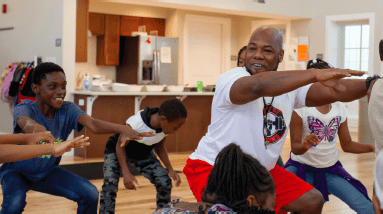
Our prime products are the development of new, green, affordable and mixed income housing, and the acquisition and renovation of existing affordable and mixed income housing. Because there is a strong demand for these, they remain fully occupied regardless of the economic cycle.
Our processes are to make our buildings as green as is economically viable; saving energy and water and using as many non-toxic materials as possible; and to develop programs that connect our residents to social, health, and educational services—partnering with an ecosystem of nonprofit organizations to provide these services.

We fund this work with public/private partnerships and private equity impact funds. These have helped us grow our top line from $92 million in 2017 to $202 million in 2019, while providing our investors—typically health system endowments, foundations, universities, nonprofits, and high-net-worth families—with reliable returns to carry out their work, and information on the role of housing and the social determinants of health.
RESPONDING TO COVID-19
When COVID-19 emerged as a threat to our residents, employees, and potentially to the bottom lines of our properties, the conditions set by our commitment to regeneration prepared us to be able to respond well.
We had a product—affordable and mixed-income housing—with a stable population, so we experienced no increase in vacancy.
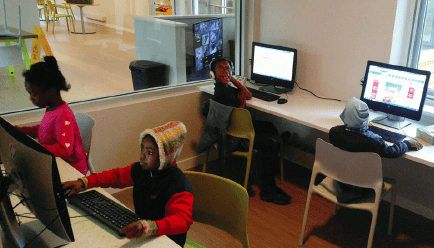
Jonathan Rose Companies
At the property level, our green building processes established a focus on the health of our residents and employees. The use of non-toxic cleaning materials and circulation of clean filtered air provided a base to work from.
Our social, health and educational programs provided us with pre-existing systems for resident engagement that were essential to maintaining resident communications and health.
At the corporate level, we designated one person to coordinate our response, and brought together a cross-sectoral group of leaders to develop solutions. We actively participated in industry networks to share our lessons and learn from others. We tracked key indicators such rent paid, and infections reported daily.
We set our prime goal as the protection of the health of our residents and employees. Seventy percent are low income seniors, a very vulnerable population, so we moved quickly, agreeing that an over-reaction would be more protective then to under-act.
To do so, we scoured the web for reliable information on the disease and its containment. We very quickly identified three key strategies: social distancing, personal protective equipment (PPE), and the frequent disinfection of common elements.
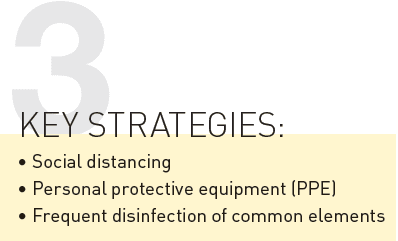
We then needed to determine how to carry these out. We closed our community rooms, and figured out how to shift their programs, such as senior feeding programs and food banks, from collective events to safe person-by-person distribution. We developed phone calling systems to stay in touch with our most vulnerable residents. We expanded ways to keep our properties operational and ensure we were able to deliver services to our residents while at the same time reducing the possibility of transmission and contributing to the national objective of flattening the curve. We had to change the ways in which we interacted with our residents; for example, helping residents to pay their rent without coming to the office, and dozens of other issues.
We also sped up our efforts to pervasively adopt a modern digital workplace, which let us collaborate from a distance.
The result of these efforts is that across a population of 22,000 residents, during the last six months, fewer than 0.0055% of our population have reported confirmed or suspected COVID-19 cases.[4]
This positive outcome came from the following principles:
1. Clearly identify the threat, its cause, and its likelihood of affecting properties, employees, residents and its prevention.
To do this, real estate organizations need to grow their outward capacity to do research, and their inward capacity to understand what is going on at the property level.
2. Bring together key managers across all sectors of the company to respond.
Manage the cross-sector committee with the clear value that all voices matter, otherwise the lower-level “field” staff are less likely to speak up.
3. Track data rigorously, and daily, to see and respond to emerging trends.
For example, we began to track rent payments daily, to identify issues. We observed rents coming in later, because many of our residents pay with money orders and were reluctant to go out to buy them. We initiated a program to help our residents set up online banking and rent payment.
4. Track budget implications carefully, but solving the crisis comes first.
Establishing health as our number-one priority, we added the cost of additional cleaning, PPE, gratitude, pay, and other items to our budgets. However, social distancing, which closed down our lobbies and amenity spaces, reduced travel costs and lower turnover led to counterbalancing reductions in costs.
5. Lead with your company values, focus on trust, identify causes of stress and its relief.
Volatility brings stress to people, systems, budgets, and more. Stress and distrust undermine our ability to think clearly and comprehensively. As soon as it became clear that the pandemic would affect us, we launched weekly sessions on the company’s values, making it clear that our values would define our solutions. We held companywide town hall meetings. We were one of the first in the industry to pay our field staff extra “gratitude pay” for their service, and to implement rigorous processes to protect them, which helped our people feel valued.
6. Communicate, communicate, communicate.
We frequently reached out to our residents, staff, investors, lender partners, city leaders, and other stakeholders to keep them informed, and to learn.
7. Use scenario planning to future cast key issues and approaches.
We are now applying our lessons learned to future potential threats. For example, in the near term, we are concerned with chaos after the election, and the risk that it may cause supply chain delays, and potential social instability. To address these, we are ordering key items now to ensure we have sufficient supplies, and stockpilingthem, while also carefully reviewing our property security plans.
Over a longer period, we are concerned about the impacts of climate change. Ensuring continuous, safe operations across our entire portfolio is vital to protecting our residents. We have been investing in systems and processes to assess climate risks and make our projects more resilient. For example, every property has a generator, in case the power goes out.
These are all steps that help us be a more regenerative company, enhancing the ecological and social commons.
—
ABOUT THE AUTHOR
A keynote presenter at AFIRE’s September 2020 Speaker Series, Jonathan F.P. Rose is the Founder and President of Jonathan Rose Companies and the the author of The Well Tempered City: What Modern Science, Ancient Civilizations and Human Behavior Teach Us About the Future of Urban Life.
NOTES
1. Kim C. Korn and B. Joseph Pine II, “The 7 Laws of Regenerative Enterprises,” Harvard Business Review, HBR.org, updated November 17, 2014, hbr.org/2014/11/the-7-laws-of-regenerative-enterprises.
2. Carol Sanford, The Regenerative Business (Boston: Nicholas Brealey, 2017), 2.
3. John Fullerton, “Regenerative Capitalism: How Universal Patterns and Principles Will Shape Our New Economy,” CapitalInstitute.org, updated April 2015, capitalinstitute.org/wp-content/uploads/2015/04/2015-Regenerative-Capitalism-4-20-15-final.pdf
4. As of August 2020.

—

